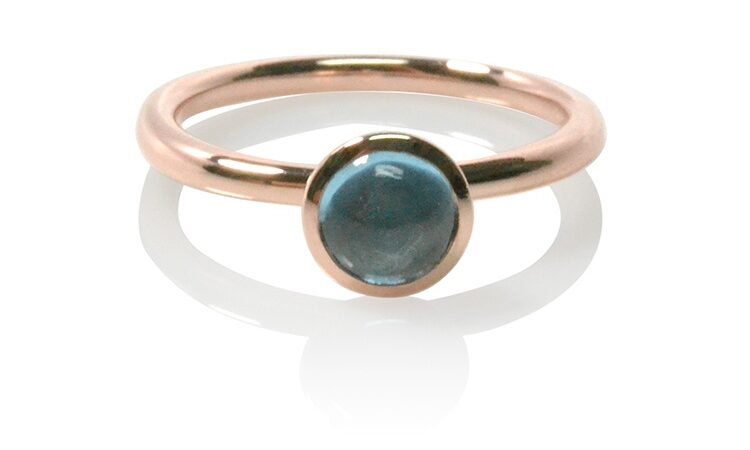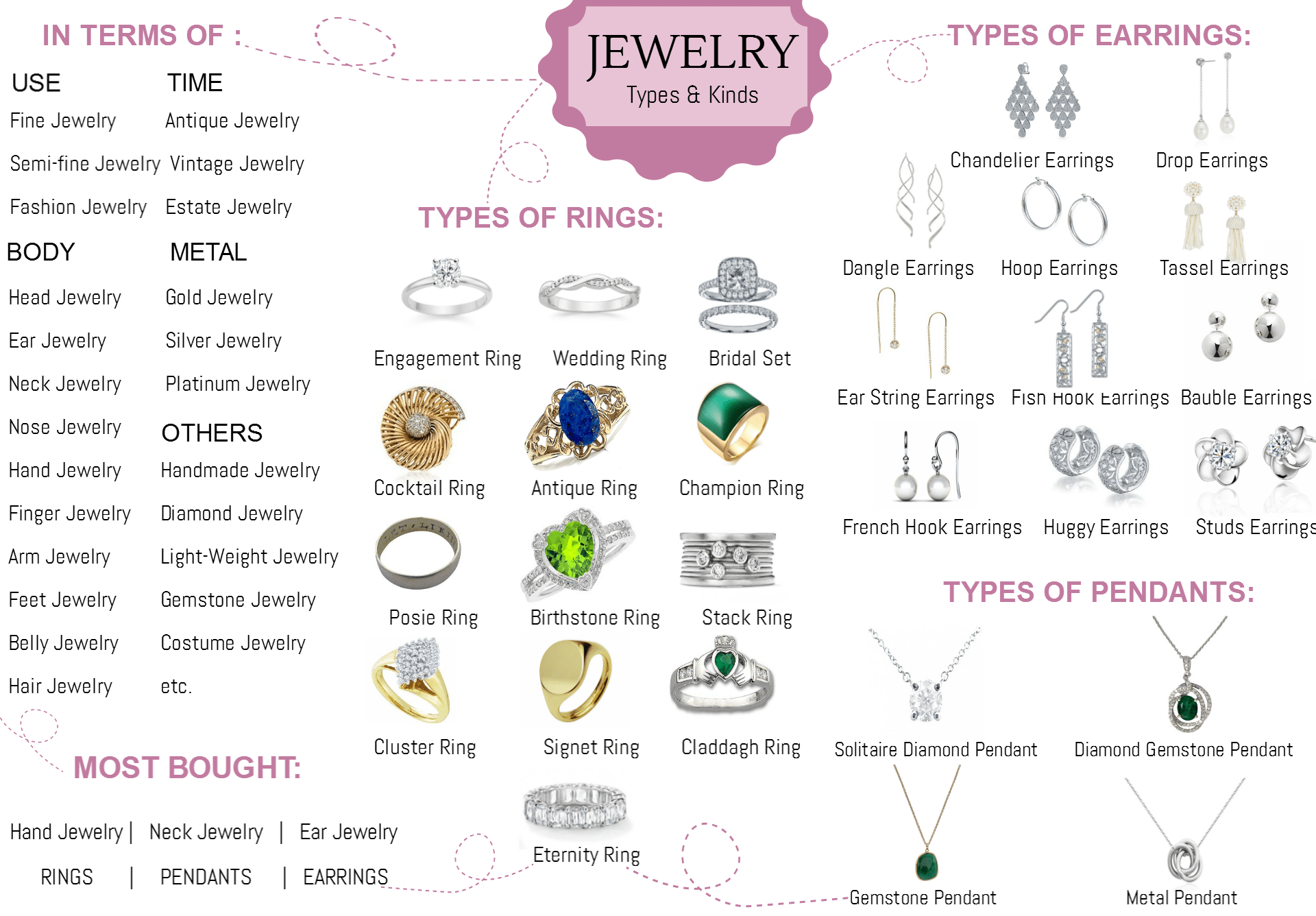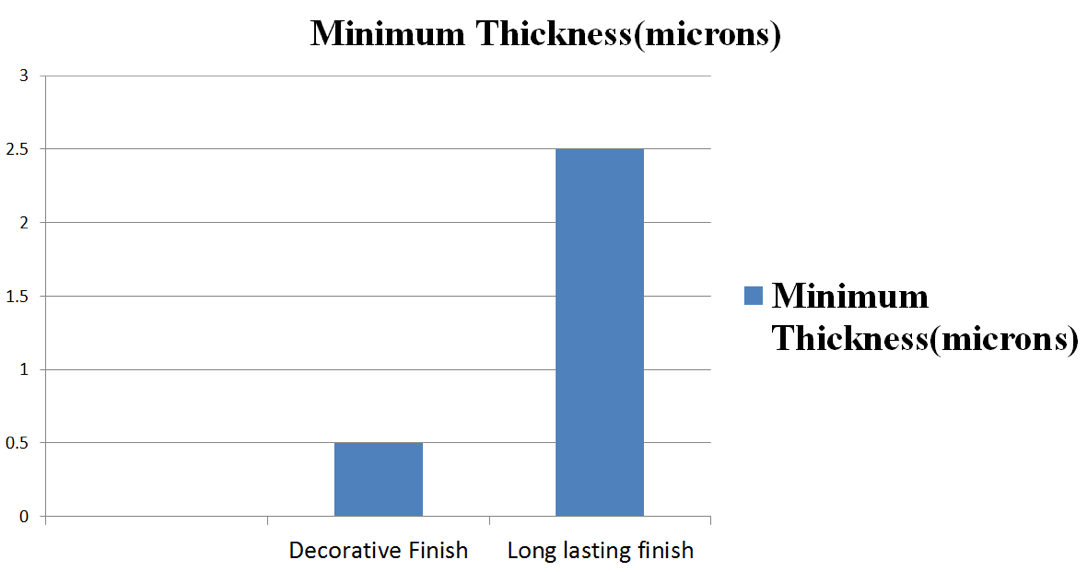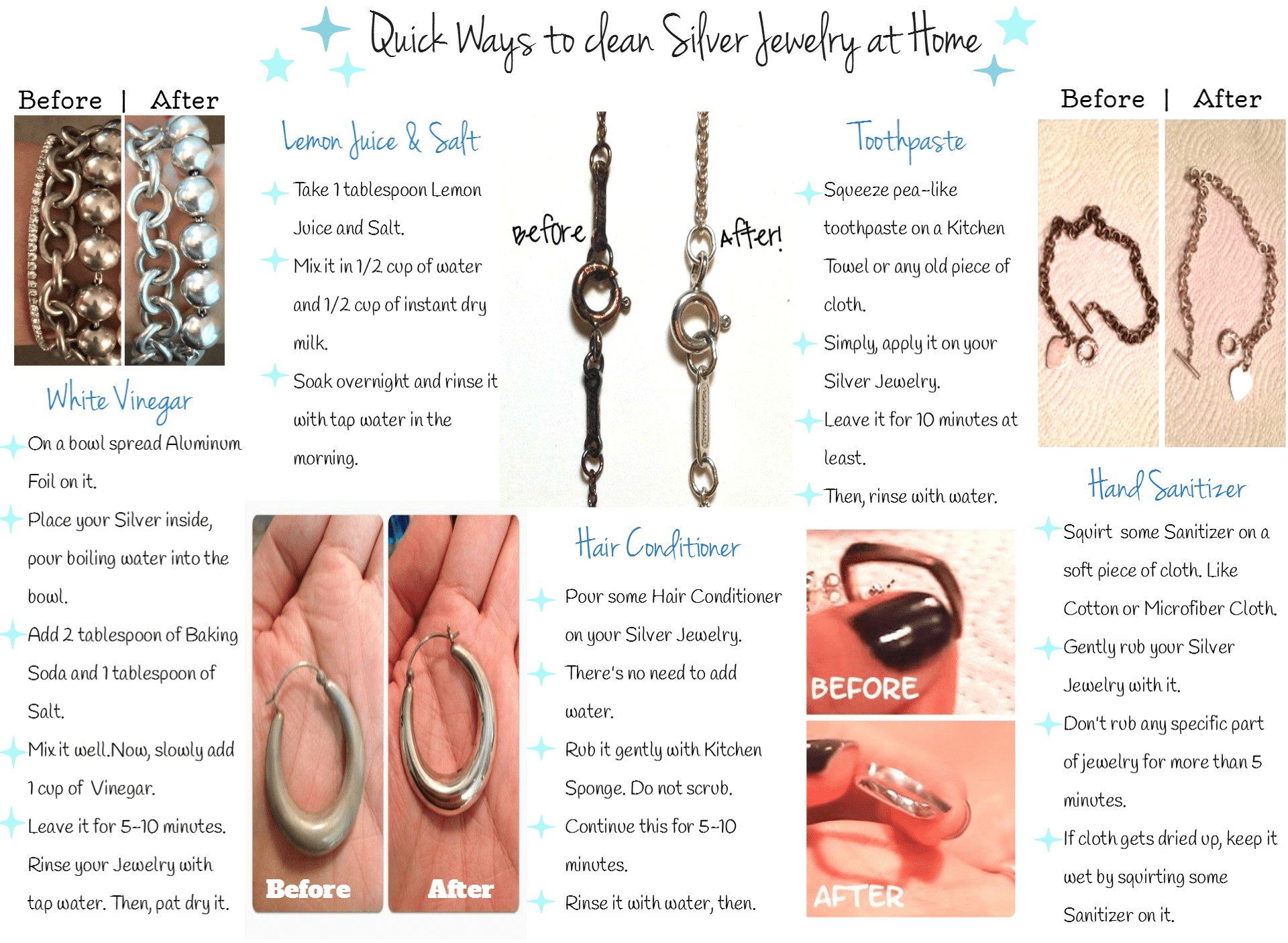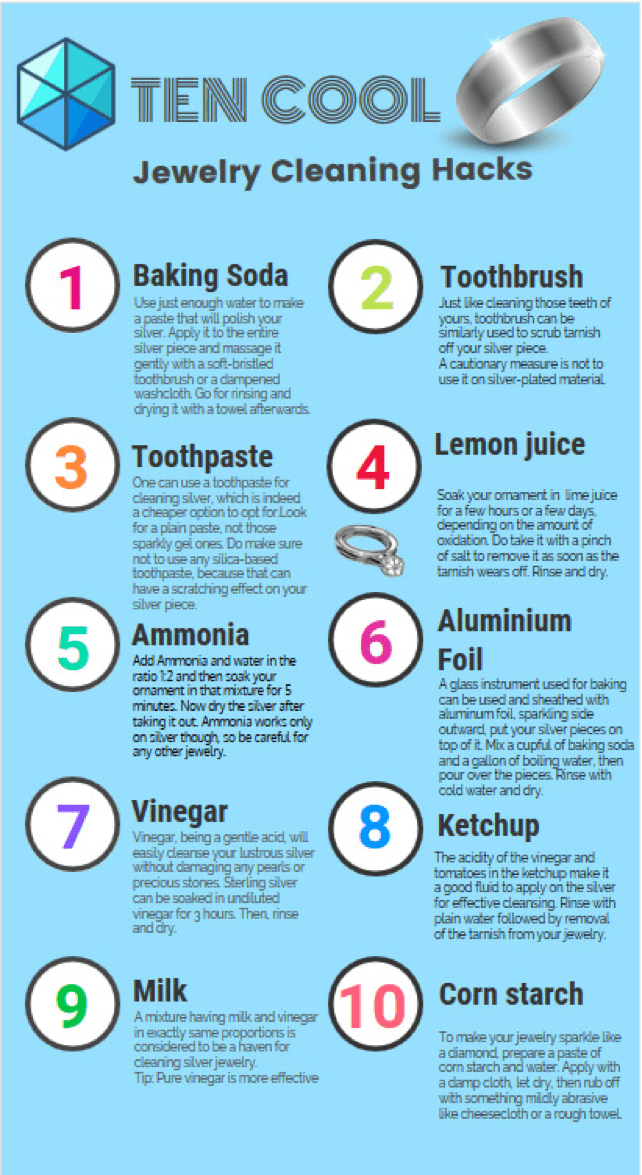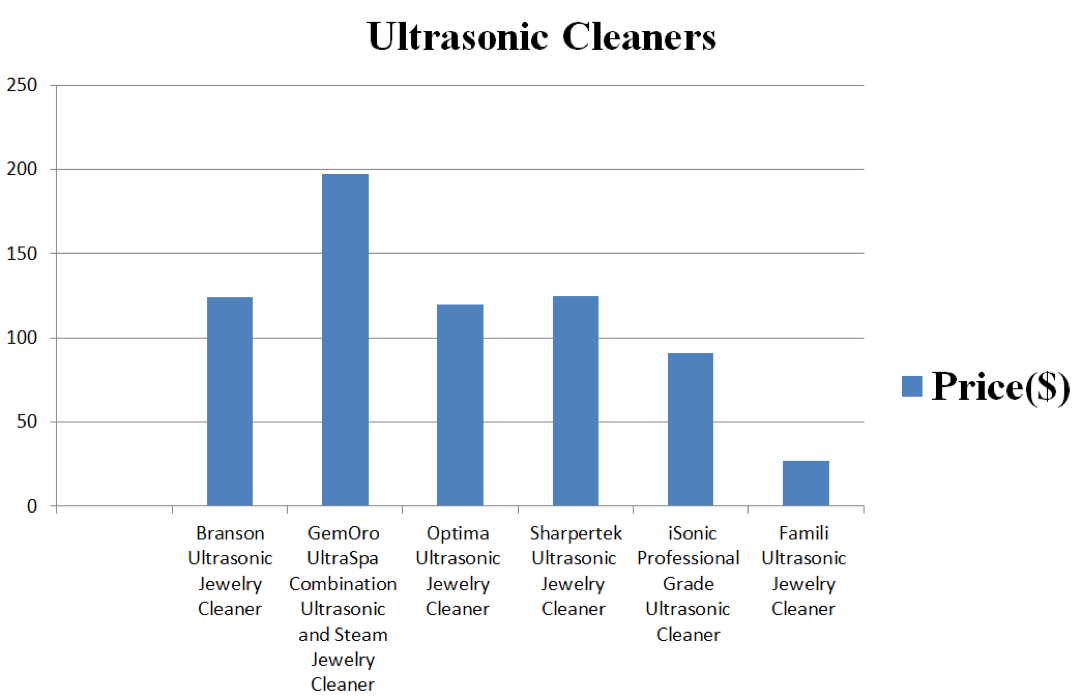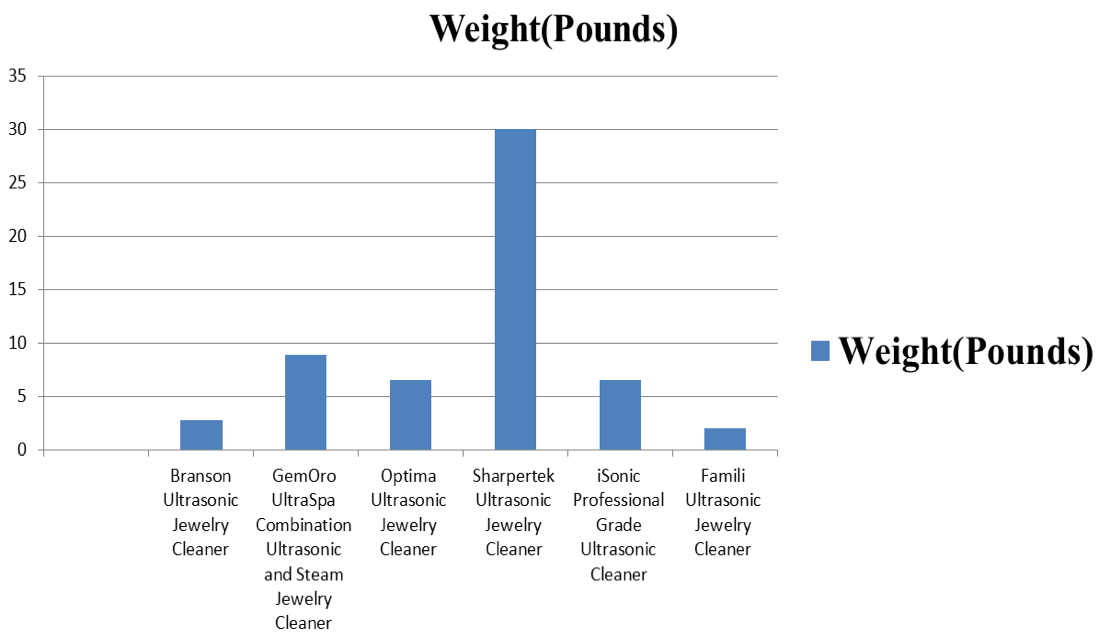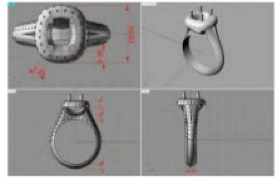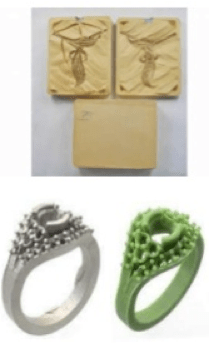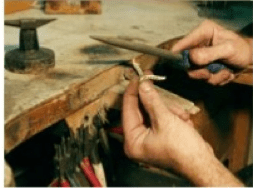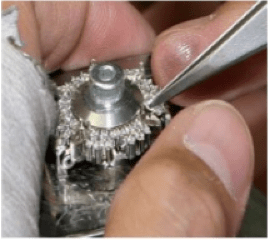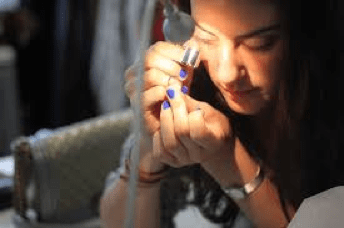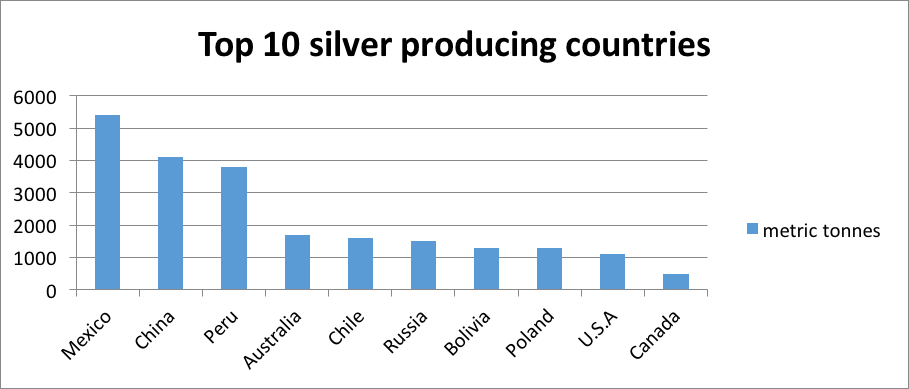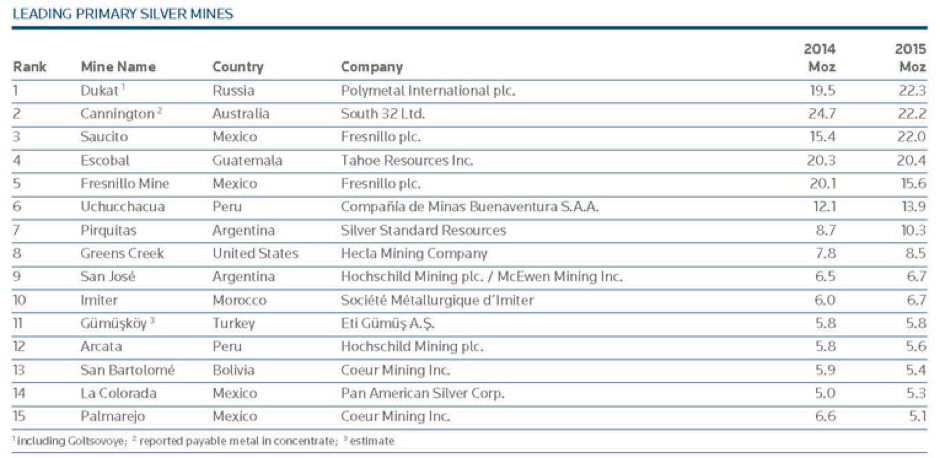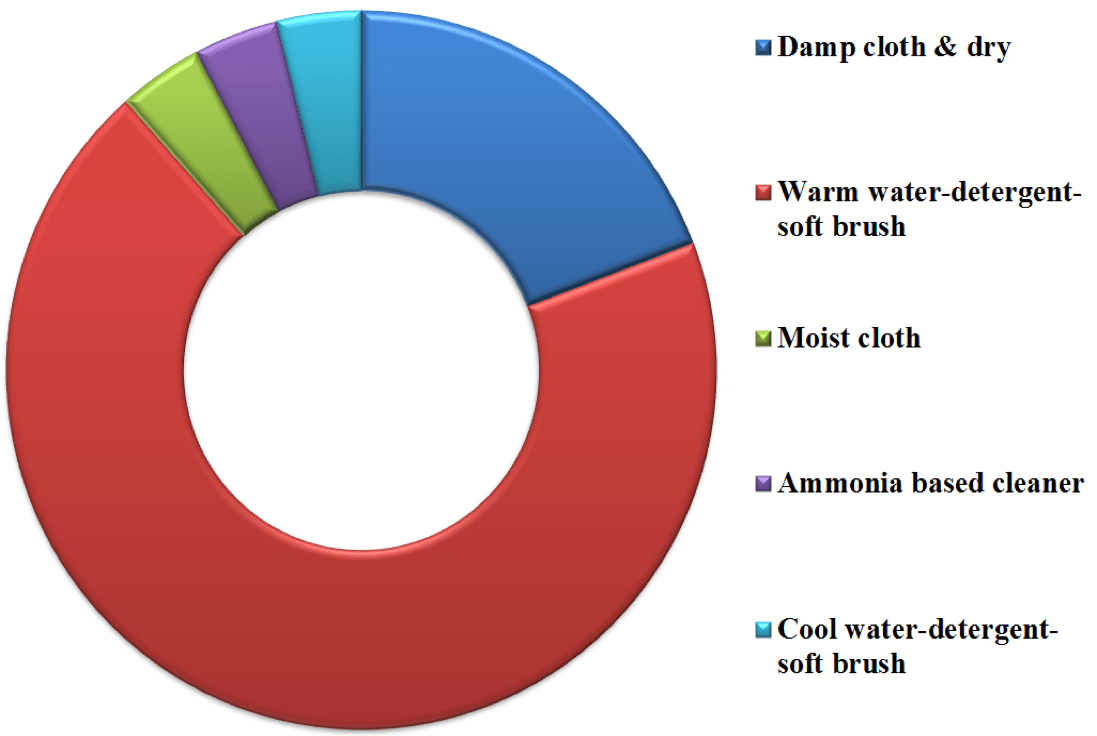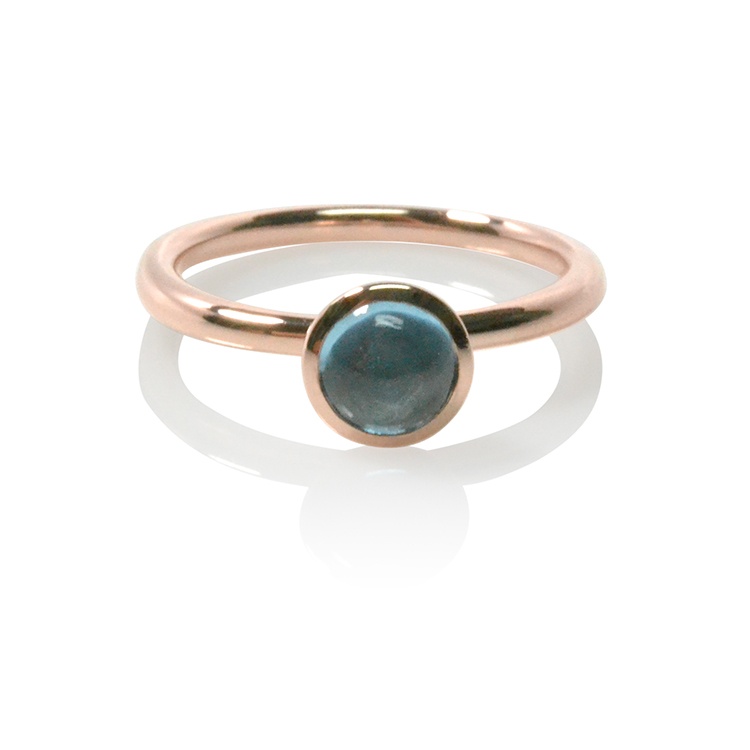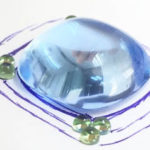How To Clean Silver Jewelry – A Complete Guide
This article we will be talking about:
1. Understanding Silver Jewelry basics
2. How the Silver Tarnish Forms (and of course later on how to clean silver jewelry)
3. How to make Silver last longer in the first place – understanding Micron plating.
4. How to Clean silver jewelry using the Ultra Sonic Cleaner and the different types of Ultra Sonic cleaners available in the market, the price of them, the weight of each.
5. Jewellery Manufacturing Process – Understanding each step
6. How to clean different gemstones with different cleaning methods
Introduction on Silver Jewelry
Silver is one of the seven historical metals which humans had identified and found use for in prehistoric times. According to archaeological surveys and consequent radiocarbon dating techniques, Silver was discovered after gold and copper. The earliest signs of Silver objects found, date approximately back to the 4000 BCE, in Greece. However, the earliest known silver workings of significant size as those of the Pre-Hittites of Cappadocia in eastern Anatolia, i.e. modern turkey. (By the way still today this part of Turkey has a huge silver jewelry production, how interesting )
Silver has ever since been considered a precious metal and has been in mankind’s use in almost every field known due to its vast number of useful properties. However, the shiny appearance, lightness, corrosion resistance to atmospheric air (moisture and oxygen), and property of easy forming of the metal even at room temperature led to its extensive use in jewelry. Although the native form of silver is less abundant than gold in nature metallurgical advancements in history made silver more easily available commercially and therefore cheaper than gold.
Silver jewelry is a beautiful addition to any ensemble but can it can fade over time. These tips will help you refreshen your silver jewelry again, simply by answering the question How to clean Silver Jewelry.
How Silver Tarnish Forms
Silver loses its luster very quickly on exposure to air and moisture. Silver reacts with hydrogen sulfide and oxygen in the air, resulting in a tarnish build-up on the surface of the silver or silver plate. Tarnish is a thin, corrosive layer that only affects the silver’s surface and is self-limiting, unlike rust which eats away at each layer of metal. Silver tarnish is dull grey or black in appearance and is often called the silver’s patina. Tarnish is less likely to form on silver that is used often, so it is recommended to wear and clean silver jewelry on a regular basis to prevent tarnish from forming. This article is an in-depth research on how to clean silver jewelry and will help you understand your silver better.
How to make your silver last longer – be a micron expert
Before we talk about how to clean silver jewelry, it will be necessary to define the “unit of measurement” that describes the electroplated layer thicknesses as professional silver jewelers do. The most common unit of measurement in the U.S. is the “Microinch”. To say it commonly, in layman’s terms, a Microinch is actually the same as one-millionth of an inch.
View this post on Instagram
For Europe and some U. S. industries (i.e. jewelry trade), the unit of measurement is often expressed in “microns.” To get an idea of just how thick one micron is, it takes 1000 microns to make one millimeter. For comparison, one can compare a U.S. dime coin which is 1250 microns or 1.25 millimeters in thickness.
Silver plating is simply the method of depositing a thin layer of silver onto a conductive surface, one of the ways to solve the problem of how to clean silver jewelry at home. The surface normally consists of a conductive metal base which allows a current to be passed through it to form a complete circuit. This allows the silver particles in the electrolyte solution to bond with the item being silver plated, the item being electroplated is also referred to as the cathode.
The classification for the thickness of silver plating relating to the solutions that we use is as follows:
- The minimum thickness for silver plating is equal to 0.5 microns. This is used mainly for a decorative finish on items that require minimal handling.
- Heavy silver plate is classed as 2.5+ microns. The normal thickness that is applied is between 2.5 – 6 microns dependent upon the item and its intended use. This provides a long-lasting finish on high-wear items such as watches, buckles, trophies, and jewelry.
- Silver plating of just 5 microns is often more than adequate for the long-term durability of high wear items if cared for properly. This will make the shine longer and you won’t have to repeatedly understand how to clean your silver jewelry.
- A general rule is to allow 1 micron in silver thickness for every year of intended use.
Conclusion:
Therefore if you are going to a professional to refurbish or know how to clean your silver jewelry, silver collectible, silver rings, or silver earrings, you can instruct your jeweller to keep the coating to 5 microns as subsequent home cleaning, which will be discussed at a later part of the article, becomes a lot easier. Get the coating checked before and after the procedure to make sure that you have what you asked for. In case you are getting decorative items like trophies and mementoes coated, 2.5 microns will suffice. Keep such items in a glass case, away from excessive exposure to air and moisture which causes tarnish. Periodic electroplating of silver jewelry will make them last longer and not let them ruin by tarnish. This is an excellent method to revive and preserve family heirlooms and antique pieces and make your 925 silver brand post again.
What to Keep in Mind When Cleaning Silver Jewelry:
Silver can be used to create beautiful pieces of jewelry that should be handled with care to ensure the longevity of each piece. Silver jewelry that is not worn frequently can often form an unattractive layer of tarnish that needs to be cleaned to make the piece wearable. The cleaning process is usually straightforward, but precautions must be made when cleaning a jewelry piece that includes or does not include any gems. When a piece is highly valuable in terms of worth or sentimentality, a professional jewelry cleaner should be used to expertly clean the piece. For wearers who opt to clean silver jewelry at home; there are a number of methods that can be used to restore the silver to its original luster. When it comes to keeping your silver jewelry looking its very best, it is extremely important to be very careful to avoid abrasive solutions.
- Scrubbing your precious silver jewelry with toothpaste or salt can remove tarnish, however, it can also lead to ugly scratches – or even wear off a silver finish entirely, if your jewelry is only silver-coated.
- If your silver jewelry wasn’t too expensive and you’re merely looking for a quick fix, you can still carefully try a paste of water and baking soda for cleaning silver, but be aware of the potential undesired consequences.
To know more about how silver can make you shine like the moon.
https://www.navneetgems.com/silver-jewellery/
HOME REMEDIES FOR HOW TO CLEAN SILVER JEWELRY
Method 1: Making a Salt Bath
- Pour two cups of hot water into a bowl. You just need enough to cover the jewelry you’re cleaning. This method works as a gentle cleanser that removes tarnish without abrading the silver. If your silver is lightly tarnished, the salt bath should take the tarnish right off.
If you’re cleaning a lot of jewelry at once, you can use more water. For just one piece of jewelry, a useless cup of water.
If your jewelry has gemstones, make sure they won’t be affected by being submerged in a saltwater solution. This solution is gentle on most stones, but if you’re cleaning very fine jewelry with expensive gemstones, you’re better off taking it to a professional just in case.
- Add salt and aluminium foil. Stir one tablespoon of salt into the hot water with a spoon until it completely dissolves. Take a sheet of aluminium foil and tear off a few strips, then put them in the bowl. The combination of salt and aluminium will react with the tarnish on the silver’s surface and create a bright, shiny surface in place of the tarnish. Cleaning silver with salt and aluminium is a great home remedy.
- Tarnish happens when the surface of silver combines with sulfur and turns into silver sulfide, which is black. When silver sulfide reacts with aluminium in a salt solution, the chemical reaction between the substances turns the silver sulfide back to silver. The reaction happens faster when the solution is warm.
- If you don’t have table salt on hand, you can use baking soda instead. It has the right properties to facilitate the same chemical reaction.
- Submerge your jewelry in the solution. Allow it to sit for 5 minutes. Stir it around a bit to see whether the tarnish is going away. When you see that the silver’s shine has been restored, remove the silver from the solution.
- If you’re working with deeply tarnished silver, you might need to repeat the process two or more times. Make sure the solution is completely heated since the reaction is much slower if the solution is cool.
- Rinse the jewelry. Run it under cool running water to rinse off the salt, then gently dry it using a soft cloth or microfiber towel. The jewelry should be good as a post. If you still see signs of tarnish, repeat the process until it looks clean.
Method 2: Deep Cleaning Silver Jewelry
- Purchase a silver polish. When tarnish develops on silver, simple salt and aluminum Foil bath may not suffice to remove it. Specially formulated silver jewelry polishes are your safest option for polishing silver jewelry, especially if you are dealing with an antique or a piece that has intricate designs etched into it.
- Even special polishes can remove a layer of silver, so get a professional cleaning if you’re dealing with a delicate piece.
- Instead of buying silver polish from the drugstore, consider getting it from a jewelry store or a store with a high-quality jewelry department.
- Rub the jewelry with a little polish. Moisten a soft silver-polishing clean cloth or the sponge included with the silver polish and take a little bit of polish onto the cloth. Rub the polish into the silver jewelry gently. Use only a straight-line, back-and-forth motion. Avoid scrubbing or rubbing in circles, since this can leave scratches or patterns on the surface of the jewelry. Just let the polish do the job.
- Rinse and dry the silver jewelry. Rinse it under cool running water. Be sure to clean off all of the polish residues so it won’t continue working on the surface of the jewelry. Dry it completely using a soft cloth.
- Consider using common household products for less rare or less valuable pieces. They will usually work to remove tough tarnish but may cause damage such as pockmarks or scratches. Try them at your own risk.
- Try toothpaste to clean silver jewelry. Select a plain white toothpaste without the special whitening options. Take a soft, dampened cloth or a damp sponge and put some toothpaste on it. Gently rub over the silver jewelry in straight, back-and-forth motions. Be very gentle, and if you notice scratching at any point, stop and rinse the toothpaste off. As the cloth or sponge becomes dark with tarnish, add more toothpaste to a clean part of the dampened cloth/sponge and continue gently polishing. Rinse thoroughly with warm water and dry with a soft towel.
- Cleaning silver jewelry with baking soda is also an option. Baking soda may remove stubborn tarnish, but don’t use it unless you don’t mind the risk of damaging the silver. Make a paste of baking soda and warm water, gently rub it into the surface of the jewelry, and rinse when the tarnish is removed.
- Try a silver dip to clean silver jewelry or silver coins. Commercial silver “dips” can dissolve stains without rubbing the silver jewelry, although they may take off a layer of silver. For this reason, they should only be used as a last resort. Contrary to what the word “dip” implies, professionals rarely actually soak the silver in these products, at least not for long. Dips are generally harsh, potentially dangerous chemicals, so follow the directions carefully and consult a professional when in doubt.
Method 3: Maintaining Your Jewelry
- Clean it often. Clean your silver jewelry often, and clean it promptly after use. Silver jewelry that is frequently used rarely has tarnish problems. When tarnish is not yet present, or when it’s just beginning to develop, simply wash your silver jewelry in warm (not hot) water with a gentle, phosphate-free detergent.
- Prompt cleaning is especially important when the silver jewelry has been exposed to certain foods containing sulfur, or those which are acidic or salty. In particular, common foods such as table salt, eggs, some fruits, onions, mayonnaise, and vinegar are harmful to silver.
- In any case, wash your silver jewelry right away or at least rinse it well with warm water, and don’t leave silver sitting in dishwater that may contain traces of these foods.
- Wash it separately. It’s a good idea to wash silver separately from your other silver pieces, like bowls or silverware, because metal sinks and utensils can scratch silver jewelry.
- You should also avoid using rubber gloves when washing silver, as rubber corrodes silver jewelry.
- Stainless steel can also damage the finish if it comes into contact with your silver jewelry, so avoid putting it in the sink; use a bowl to wash it in instead.
- Dry it with a polishing cloth. Use a special polishing cloth or simply a soft, lint-free cloth to gently rub the silver clean after washing. Make sure it gets completely dry.
- Silver can be so soft that even using a scratchy, rough towel could be enough to make indentations on its surface. Make sure to use a soft cloth.
- As you dry the jewelry, gently buff the shine back with a soft cotton cloth.
- Store your silver jewelry correctly. Beyond prompt and frequent cleaning, the best way to preserve your silver is to store it correctly. Make sure each piece is completely dry before storing it. You can buy special bags for storing silver jewelry that prevent them from getting tarnished. If you don’t have the bags, use this technique:
- Wrap each piece of silverware in acid-free tissue paper, paper towels, or anti-tarnish paper. You can also wrap pieces in flannel.
- Store the silver in a compartment separate from the rest of your jewelry. Never store silver jewelry where it can contact rubber, stainless steel, or paint.
Ultrasonic Jewelry Cleaning
Another highly professional method to knowing how to clean silver jewelry is the use of ultrasonic cleaning equipment. Ultrasonic jewelry cleaners use inaudible sound waves to create tiny vacuum bubbles in the liquid in the receptacle. The bubbles collapse, creating a great deal of heat and pressure, and ‘blast’ nearby objects. Millions of these little bubbles reach into intricate spaces right before bursting, making the process an effective cleansing tool for some jewelry and its embedded components. These cleaners are designed in somewhat different ways but each comes with a basket to hold jewelry.
NOTE:- Not all jewelry is suitable for ultrasonic cleaning. Here are the do’s and don’t’s on how to clean your silver jewelry using an ultrasonic cleaner.
- Pearls, opals, turquoise, emeralds, and other similar, more delicate, gems should not be placed in an ultrasonic cleaner. (More information for every gemstone is towards the bottom of the page)
- Fashion jewelry would possibly be damaged by these cleaners, and it’s best to find another method to clean your delicate vintage and antique jewelry.
Despite the limitations, these devices work well on post diamond jewelry. If you have your heart set on getting a professional diamond jewelry cleaning while at home, consider one of the ultrasonic jewelry cleaners listed below as your solution to home-made solution to cleaning silver. But this works absolutely great for cleaning silver rings, earrings, etc.
1. Branson Ultrasonic Jewelry Cleaner
Like most other ultrasonic cleaners in this collection, some Branson units are large enough to clean eyeglasses and other small items. This model is compact and highly rated. It is a bit more pricey than some other cleaners on this list, but it is powerful enough to clean even the dirtiest piece of jewelry. Usually rings.
Product Features
- Operates on 110-120V AC, 50-60 Hz
- Includes 5-minute timer
- A wide variety of other applications include: instrument and clock parts, small geological samples, metal, and plastic machine parts, small electrical and electronic components
2. GemOro UltraSpa Combination Ultrasonic and Steam Jewelry Cleaner
This cleaner uses tap water and combines ultrasonic capabilities with steam cleaning. The ultrasonic tank holds about a pint of liquid (the tank isn’t quite as large as some of the other models, but would be perfect for most jewelry). The great thing about this device is its dual purpose. It is both an ultrasonic and steam cleaner. Use the ultrasonic to loosen grime then use the steamer to blow the grime and excess cleanser away.
Product Features
- The World’s Only Ultrasonic/Steamer Combination
- 50 PSI Steam Pressure/1 Pint Tank Capacity
- 1 Pint Tank Ultrasonic with 42000 Waves Per Second
- 1 Year Limited Replacement Warranty
- Timed 6 Minute Cleaning Cycle
3. Optima Ultrasonic Jewelry Cleaner
The Optima jewelry cleaners in this collection vary in price, starting at about $35 and extending to $135. Tub size and cleaning cycles vary. Be sure to read the feedback — the lowest-priced cleaning unit has not accumulated good reviews. This particular unit is on the upper end of the price range but has better reviews.
Product Features
- Large tank ultrasonic machine
- 5 cycle digital timer
- Built-in heater up to 65 degrees
- A strengthened transducer makes the ultrasonic more powerful (42 kHz and 160 Watts cleaning power) and provides remarkable cleaning results.
- Cleaning Concentrate Powder included
4. Sharpertek Ultrasonic Jewelry Cleaner
You’ll find a wide variation in Sharpertek cleaners, in both price and capabilities. Some of the units are heated, although many of those styles are larger cleaners that can also be used to clean auto parts and other items way beyond your needs for jewelry. You’ll even find the larger versions in fine jewelry stores.
Product Features
- Large Digital Timer Display for Precise Control of Cleaning Time
- Wide dipping tub with a spill-proof cover that can safely store tarnish-removing solution between uses.
- Wide-Diameter Transducer for More Powerful Cleaning Cycles
- Industrial Grade IC. Multiple Circuit Protections. Moister Proofed PCB. Cooling Fan.
5. iSonic Professional Grade Ultrasonic Cleaner
This professional-grade ultrasonic cleaner is an affordable way to get a large cleaner you may otherwise find in jewelry stores. The powerful ultrasonic frequency is paired with a built-in heater.
Product Features
- Digitial timer: 180, 280, 380, 480 and 90 seconds.
- Large tank size: 9.6″x5.9″x3″. Tank capacity 2.6 Qt / 2.5 L.
- Power: 110V 160W including the heater. (220V available with extra charge)
- Come with a full-size plastic basket.
- Ultrasonic frequency: 42,000 Hz.
6. Family Ultrasonic Jewelry Cleaner
If you’re buying your first ultrasonic jewelry cleaner, this device is a great option. It is small and has great reviews. It is also the least expensive option on this list. The product promises to clean your precious jewelry without the need for harsh chemicals or abrasive scrubbing.
Product Features
- Safely cleans dirty, discolored, or tarnished jewellery, eyeglasses, and watches, CDs/DVD’s, utensils, and more in a matter of minutes using water.
- Generates 42,000 Hz of ultrasonic sound waves for a powerful yet gentle clean that won’t damage your valuables.
- Extremely easy to operate with 5 pre-set cleaning cycles (90, 180, 300, 480 & 600 seconds), with an automatic shut-off feature to conserve electricity.
- Easy to read digital display, quiet and portable, it is easy to store and very convenient to use. 600 mL / 0.6L capacity, CE & RoHS Certified, safe, and environmentally friendly.
- Famili offers a 1-year warranty to be free from defects in material and workmanship.
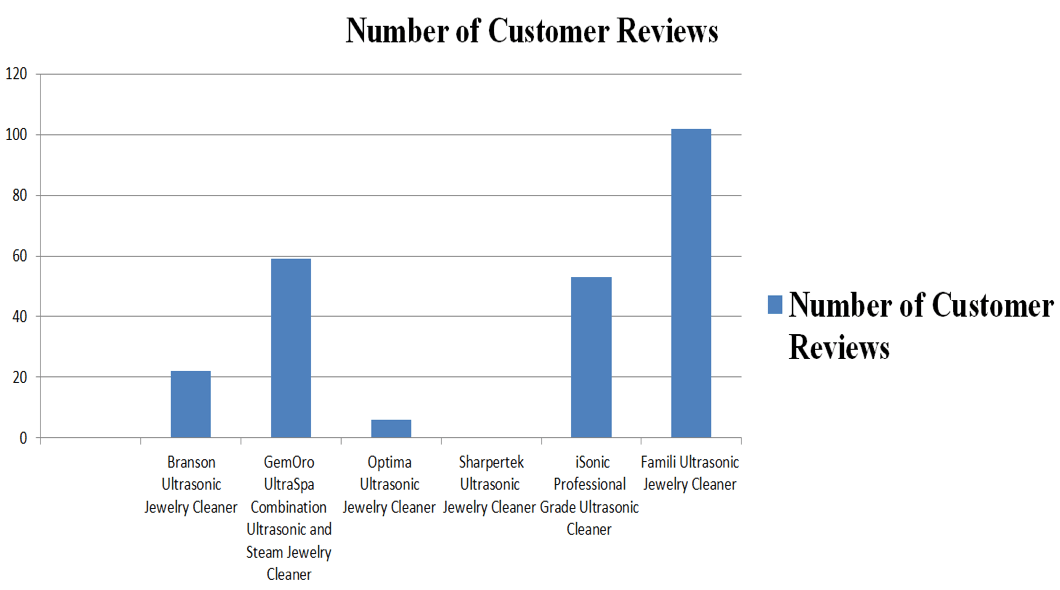
Fig. 3 and Fig. 4 show that 102 customers preferred the lightweight (2 pounds) Family Ultrasonic Jewelry Cleaner because of its portability and easy usage.
CONCLUSION:
Since all of these ultrasonic cleaners are easily available online, one can always plan on investing in one of these, especially if you are an extended user of 925 silver and would require intense cleaning of silver jewellery. These come for multiple uses and not just for cleaning silver jewelry. You can clean silver plates, silver coins, and virtually any silver item as long as it fits into the basket.
For a first buy, according to the above research, the Famili Ultrasonic Jewelry Cleaner is a good buy to solve your problem of how to clean silver jewelry. It is compact, portable, and most importantly, extremely cheap. These factors make it one of the most popular buys off the internet. The GemOro UltraSpa Combination Ultrasonic and Steam Jewelry Cleaner ups it another notch with both an ultrasonic cleaner and steam wash mode. However, it is THE costliest item on the list and that definitely doesn’t increase its online popularity quotient. If you want to go midway, the iSonic Professional Grade Ultrasonic Cleaner makes for an affordable, light choice.
While buying one of these machines online, make sure that it meets your requirements in terms of jewelry quantity, washing and scrubbing requirements, weight, price, and portability. So in case you have been asking yourself, how to clean silver jewelry, your answer is tabulated right here.
Jewelry Production
Silver’s purity is typically measured on a per-mille basis, with some percent silver and rest percentage consisting of copper and other impurities, for e.g.:
- Fine silver: 9% silver (999 fine silver). It is also called pure silver. It is too soft for general use and used for investment purpose.
- Britannia silver: 84% silver (958 fine silver). Was developed for Britain sterling silver coins.
- Sterling silver: 5% silver (925 fine silver). Sterling silver is a silver jewelry standard in many countries and has been since the 14th century. This popular alloy is ideal for silver earrings, silver bracelets and silver necklaces because its durability ensures pieces will stay securely fastened when worn.
Infact in the US, only alloys with at least 0.900-fine silver can be sold as “silver” (frequently stamped as 900 silver) and is usually followed by every Silver Jewelry Wholesaler.
Crafting unique Silver jewelry is an operation specific process and involves a lot of time and skill. Except for personalized silver jewelry which are primarily handcrafted, most of it is executed by casting machines. Following is a brief description of all the processes involve in the manufacturing chain.
- DESIGNING: In order to produce a unique jewelry piece, the very initial step is to create a basic design. Earlier done by hand, nowadays it is done usually through an AutoCAD or other designing softwares. The designer’s concept and drawings are used by the Model maker to create a highly accurate original piece of silver Jewelry.
- MOULDING: Once the master piece of jewelry is complete, it is used to make a high precision mold, which in turn is used to make wax reproductions of the jewelry. Another method is to make a master mold from the drawings. It is a very critical level of crafting silver items as the final outcome rests on the master mold.
- CASTING: In casting the wax replicas are placed in steel containers which are then filled with investment powder. The containers are heated in a chamber to 550°C which solidifies the powder and melts the wax leaving behind a perfect cast. Liquefied metal is then poured into the flasks, allowed to cool, then demolished to reveal the jewelry in casting form.
- FILING: Filing is an essential technique in jewelry making and although simple in concept, it requires a skillful hand and much practice, combined with the right equipment and tools for required outcome. Filing Precious Metals Filing is used in jewelry making to remove excess metal, even out surfaces, smooth or to shape, form and texture pieces. This process is also used to make simple silver rings from silver wires of specific lengths.
- POLISHING: The entire mount is carefully made and polished to the highest degree of smoothness so that each and every part is attractively polished off. After stage setting, the polisher gives the jewelry a concluding polish. All tinctures of the polishing compounds and rouge must be carefully got rid of either by careful washing by hand, or by use of supersonic cleaning baths.
- FINISHING: Once the casting process is over, they are then foiled and extreme attention is given for a smooth and soft finish. These castings are then hand finished in order meet high standards – adding adjustments and settings.
- PLATING: Considerable technical improvements have been made in plating, especially in the Plating jewellery trade. Most plating is done by electro- deposition of rhodium, copper, chromium or other metals by passing an electric current through a solution and then channelizing the plating metal from the piece of pure metal to the object set aside in the solution. Special attention must be paid to fabricating and polishing procedures because it is vitally significant that the product to be plated should be perfectly finished in advance. Moreover, some of the stones which are already set, may not be suitable for plating. Stones like: Mystic quartz, Emerald, Glass fill Ruby etc, mostly treated stones.
- DECORATION: After all the above processes the required decorative gemstones of the correct sizes and weight are cut and made with extreme precision and are assorted for the final setting. Applied wire, which may be drawn or stamped out, can also be, classified as inherent decoration.
- QUALITY CHECK: The product is now brought to the quality check department where each and every piece is checked with excessive attention and thoroughly examined for any defects. This process of quality checking is done by very experienced workers and all the defected pieces are sent back to the respective departments.
Mining and Refining
Silver is rarely found in its native form as nuggets and is usually found in nature as an alloy with gold. Silver is also found in combination with various types of ore deposits. An ore is defined as a type of rock that contains sufficient minerals with important elements including metals that can be economically extracted from the rock. The ores are extracted from the earth through mining; they are then refined to extract the valuable element, or elements. Following are the top ten silver producing countries according to latest stats:
(Stats based on latest estimates from U.S geological survey, site-Investing post network, dated-1/Aug./2016)
Some of the leading mines of the world producing silver are as follows:
(1Million ounce (Moz) =28.349metric tonne) (Material and statistics in this section were adapted in part from the Silver Institute’s World Silver Survey 2016 publication.)
Now the interesting fact is that approximately only 25 percent of the silver produced comes from ores actually mined for their silver value; the major 75 percent comes from ores that have as their major metal value either lead, copper or zinc. Hence silver is usually obtained as a side product in the extraction processes of electrolytic copper refining, gold, nickel, zinc refining and by application of the Parkes process on lead bullion the ore of which also contains silver.
In the last century, post technologies have contributed to a massive rise in overall silver production. Major breakthroughs included steam-assisted drilling, mine dewatering, improved haulage and many more methods. Furthermore, advances in mining techniques enhanced the ability to separate silver from ores which wasn’t possible earlier and enabled the industries to handle larger volumes of ore that contained silver.
Now it’s important to know this as many of the high-grade ores throughout the world had largely already been depleted by the end of the 19th century! Therefore inventions of all these methods were critical to continue the increased volume of production.
CONCLUSION:
Silver is subject to oxidation, erosion, incrustation and tarnish. Processes viz. finishing and plating enhance the durability of silver, preventing and mitigating the harm caused by the environment it is kept in. Therefore, it is important for the cleaner and user to understand the processes involved in the manufacturing chain of silver jewelry. This helps in better appreciation of this metal and how to take care of it during its lifetime.
Now it’s important to know this as many of the high-grade ores throughout the world had largely already been depleted by the end of the 19th century! Therefore inventions of all these methods were critical to continue the increased volume of production. In case you arent planning on investing in silver anymore, it becomes all the more important to understand how to clean your silver jewelry and maintain them.
What to Keep in mind when Cleaning Silver Jewelry:
Silver can be used to create beautiful pieces of jewelry that should be handled with care to ensure the longevity of each piece. Silver jewelry that is not worn frequently can often form an unattractive layer of tarnish that needs to be cleaned to make the piece wearable. The cleaning process is usually straightforward, but precautions must be made when cleaning a jewelry piece that includes or not include any gems. When a piece is highly valuable in terms of worth or sentimentality, a professional jewelry cleaner should be used to expertly clean the piece. For wearers who opt to clean silver jewelry at home; there are a number of methods which can be used to restore the silver to its original luster. When it comes to keeping your silver jewelry looking its very best, it is extremely important to be very careful to avoid abrasive solutions.
- Scrubbing your precious silver jewelry with toothpaste or salt can remove tarnish, however it can also lead to ugly scratches – or even wear off a silver finish entirely, if your jewelry is only silver-coated.
- If your silver jewelry wasn’t too expensive and you’re merely looking for a quick fix, you can still carefully try a paste of water and baking soda for cleaning silver, but be aware of the potential undesired consequences.
To know more about how silver can make you shine like the moon.
https://www.navneetgems.com/silver-jewellery/
Fig 1. Common Cleaning Methods
Conclusion:
From this information graphic we conclude that warm water-detergent-soft brush is the most common method of cleaning. The easy availability of all the components of this kit perhaps makes this method extremely useful. However one should be careful to specifically use a soft brush as hard ones can cause scratches on the metal. Warm water helps break down the dirt more effectively than cold water. This method is best suited if you don’t want to use a chemical abrasive agent like ammonia.
SILVER JEWELRY WITH GEMSTONES
Most wholesale silver jewellery is encrusted with precious and semi-precious gemstones and hence it becomes mandatory to take care of the stone as much as the silver. Here are a few popular gemstones which are popularly paired with silver and need special attention.
Table 1. Cleaning Methods for various Gems
| Gemstone | Cleaning Technique | Comment |
| Amber | Damp cloth & dry. Warm water-detergent is also effective. | Amber is an organic gem, sort of a fossilized and hardened form of resin from ancient pine trees. |
| Amethyst | Warm water-detergent-soft brush | Most amethyst is heat-treated to bring out best color, but it can crack as well as fade if exposed to high temperatures. |
| Aquamarine | Warm water-detergent-soft brush | This blue beryl is also heat-treated to bring out its blue color. Heat can still cause color fading. |
| Carnelian | Moist cloth. Rub with dry cloth briskly. | It’s a tough variety of the quartz group. Wax won’t adhere to it, so it was famous as a seal material. |
| Citrine | Warm water-detergent-soft brush | A heat-treated quartz, it will fade when exposed to heat. |
| Coral | Damp cloth & dry. | Another organic gem which comes from the exudations of tiny marine animals. Extremely sensitive to flame, heat. |
| Diamond | Ammonia based cleaner. Warm water-(grease cutting) detergent-soft brush. Mechanical cleaning systems | Diamonds can take heat well, but mechanical systems could pose danger if stone is not examined well beforehand. Removing any grease the key to diamond brilliance. |
| Emerald | Warm water-detergent-soft brush | Most emeralds are routinely bathed warm oil after fashioning to improve color. Sometimes a dye is added. Mechanical systems could boil out the oil. Inclusions in emerald often weaken the stone, and mechanical systems have potential to cause breakage. |
| Garnet | Warm water-detergent-soft brush | Relatively hard and tough, garnets are heat sensitive. |
| Helidor | Warm water-detergent-soft brush | These yellow beryl gems tend to be flawless, reasonably hardy and tough. Temperature extremes should be avoided, though. |
| Ivory | Wipe clean with damp cloth & dry. Also, warm water-detergent-soft brush. | Another organic gem consisting of calcium phosphate. It’s sometimes dyed so harsh chemical cleaning could impair its appearance. |
| Jade | Warm water-detergent-soft brush | Both jadeite and nephrite are tough with little to worry about. Takes a high lustrous polish which takes professional equipment if surface needs re-polishing. |
| Kunzite | Warm water-detergent-soft brush | Has distinct cleavage plane which opens with little impact. Sunlight causes its lavender color to fade; this is definitely a “night stone.” |
| Lapis | Warm water-detergent-soft brush | Material is porous, varies greatly, is often dyed to improve color. |
| Malachite | Cool water-detergent-soft brush. | Polishes bright but wear can cause finish to dull; rub briskly with wood to help restore finish. Sensitive to acid, ammonia, heat and hot water. |
| Opal | Warm water-detergent-soft brush | Very sensitive to pressure and thermal shock (hot or cold) which causes crazing (surface cracking). Soft and fragile. |
| Pearl | Wipe with damp, soft cloth. Stains should be removed with mild soapy solution on rag – don’t dip it into liquid. Dry thoroughly. Blow out drill holes carefully; moisture there often causes discoloration. | Special care is required to keep pearls looking their best. (See more complete discussion later in this chapter.) |
| Peridot | Warm water-detergent-soft brush | One of the softer gem materials, it is attacked by acids (it etches) and heat may cause damage. Uses carefully because peridot is soft and surface scratches diminish finish. |
| Ruby | Warm water-detergent-soft brush | More and more rubies are being oiled and mechanical cleaning could remove this oil. High heat, though, could cause damage because of inclusions and other imbedded crystal materials. |
| Sapphire | Warm water-detergent-soft brush | It’s the same material (corundum) as ruby so same treatment applies: oil may be added for color, and inclusions may weaken normally tough structure. |
| Spinel | Warm water-detergent-soft brush | Hard and durable, spinels tend to be flawless in gem grades. Should give little trouble, and hold its beauty. |
| Tanzanite | Warm water-detergent-soft brush | Blue color is created by heat treatment, but tanzanite is fragile, relatively soft, and sensitive to heat, vibrations. |
| Turquoise | Wipe with damp cloth; wipe dry immediately. | Turquoise is a porous material so avoid soap, detergents, cleaning solutions. They tend to penetrate the material’s pores, turning turquoise green and/or unattractive off-color blue. |
| Topaz | Warm water-detergent-soft brush | Easy cleavage makes mechanical cleaning relatively dangerous, both for vibrations or heating. Stone may have undue pressure points caused by setting prongs. |
| Tourmaline | Warm water-detergent-soft brush | Reasonable hard gem but tends to be brittle. Pink variety often flawed, could be structurally weak and thus vulnerable to vibration damage. Moderately sensitive to heat. Bi-colored crystal sometimes split at color junctures |
| Zircon | Warm water-detergent-soft brush | Prone to impurities, it can be affected by heat extremes, although fine blue and white zircon is heat treated. |
Embellish your silver jewellery with Blue Topaz
For the many individuals who own a piece of silver jewellery containing blue topaz, it is known that one of the most important components of caring for one of these pieces is cleaning the topaz stone. Much like diamonds and other fine gemstones, topaz can become dull and dirty with daily wear, and this stone needs periodic cleaning to restore the piece to its previous luster.
This is particularly true when topaz appears on items such as rings that get dirty easily. With a general understanding of this gemstone and what it takes to keep the stone clean and sparkling, any person can effectively restore and take care of their blue topaz pieces.
About Blue Topaz
Blue topaz is a bright-colored gemstone made of a hard material and then treated to give the stone its beautiful color. When compared to similar-looking gemstones, such as aquamarine, this stone is very affordable and can be a budget-friendly, yet beautiful addition to any fine jewelry piece. According to reports, after sapphire blue topaz is the most popular colored gemstone on the market. In order to properly care for this gemstone and keep it bright and shiny, the stone needs routine cleaning. Most fine jewelers clean blue topaz pieces for free. However, for those who are interested in cleaning their topaz on their own, there are ways to clean this gemstone using household products.
Discover more about the beauty and mysticism of Blue Topaz here.
Tools for Topaz Cleaning
The process of cleaning and restoring blue topaz is rather simple, but the process requires a few simple tools.
- a small bowl
- warm water
- dish soap
- soft cloth
- old toothbrush
Always clean blue topaz by hand; never put this stone in an ultrasonic cleaner. The power of one of these tools can damage a softer stone like topaz.
How to Clean and Restore Blue Topaz
When it comes to cleaning a piece of blue topaz, whether it is a separate piece of the stone, or part of an item of jewelry, it is important to clean the stone with care, following a few simple steps.
- Squirt a small amount of dish soap into a bowl of warm water, and place the blue topaz inside, allowing it to soak for at least 20 minutes.
- Remove the stone from the water and use a toothbrush to scrub it carefully.
- Wash off any lathered soap by dipping the stone back in the water.
- Do this until the stone is clean, making sure to scrub the areas around the stone’s setting, as this often holds a great deal of dirt.
- Dip the stone into clean water to remove any soap or residue.
- Dry off the blue topaz with a soft cloth, gently rubbing the stone to return it to its previous luster.
- Repeat this process, as needed, whenever the stone starts to look dirty.
If the blue topaz is flawless, which is the standard of quality for most fine topaz pieces, then light should travel unhindered through the stone. The top of the topaz piece should also be smooth and highly reflective.
When this type of stone is properly clean, it will twinkle and shimmer much like a diamond or other fine gemstone.
Caring for Blue Topaz After Cleaning
After restoring a blue topaz to its original luster, it is important to understand the best ways to keep this gem looking its best. There are several considerations to take, after cleaning, when it comes to topaz care.
- Topaz can fade and become pale in the sun, so keep it out of bright sunlight when possible.
- Wrap each piece of stone in its own cloth when storing, keeping it from touching other pieces, so that harder stones, like diamonds, do not scratch it.
- Keep blue topaz away from harsh chemicals to prevent the stone from getting damaged.
With consistent care and routine cleanings, any jewellery piece with real blue topaz can continue to shine and shimmer for many years
